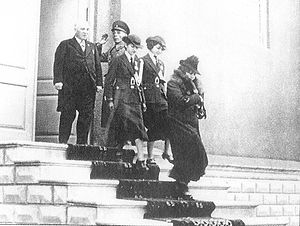
Back كشف الحجاب في إيران Arabic کەشفی حیجاب CKB کشف حجاب در ایران Persian Kashf-e hijab French キャシュフェ・ヘジャーブ Japanese Kashf-e hijab Portuguese Кашф-э хиджаб Russian Kashf-e hijab Swedish İran'da örtünmenin yasaklanması Turkish

| Part of a series on |
| Islamic female dress |
|---|
| Types |
| Practice and law by country |
| Concepts |
| Other |
On 8 January 1936, Reza Shah of Iran (Persia) issued a decree known as Kashf-e hijab (also Romanized as Kashf-e hijāb and Kashf-e hejāb, Persian: کشف حجاب, lit. 'Unveiling') banning all Islamic veils (including hijab and chador), an edict that was swiftly and forcefully implemented.[1][2][3][4][5] The government also banned many types of male traditional clothing.[6][7][8]
The ban was enforced for a period of five years (1936–1941); after this, women were free to dress as they wished for forty years until the Iranian revolution in the 1970s, when the reverse ban against unveiling was introduced. One of the enduring legacies of Reza Shah is turning dress into an integral problem of Iranian politics.[9]
- ^ Hoodfar, Homa (fall 1993). The Veil in Their Minds and On Our Heads: The Persistence of Colonial Images of Muslim Women, Resources for feminist research (RFR) / Documentation sur la recherche féministe (DRF), Vol. 22, n. 3/4, pp. 5–18, Toronto: Ontario Institute for Studies in Education of the University of Toronto (OISE), ISSN 0707-8412
- ^ Milani, Farzaneh (1992). Veils and Words: The Emerging Voices of Iranian Women Writers, Syracuse, New York: Syracuse University Press, pp. 19, 34–37, ISBN 9780815602668
- ^ Paidar, Parvin (1995): Women and the Political Process in Twentieth-Century Iran, Cambridge Middle East studies, Vol. 1, Cambridge, UK; New York: Cambridge University Press, pp. 106–107, 214–215, 218–220, ISBN 9780521473408
- ^ Majd, Mohammad Gholi (2001). Great Britain and Reza Shah: The Plunder of Iran, 1921–1941, Gainesville: University Press of Florida, pp. 209–213, 217–218, ISBN 9780813021119
- ^ Curtis, Glenn E.; Hooglund, Eric (2008). Iran: A Country Study, 5th ed, Area handbook series, Washington, DC: Federal Research Division, Library of Congress, pp. 28, 116–117, ISBN 9780844411873
- ^ Katouzian, Homa (2003). "2. Riza Shah's Political Legitimacy and Social Base, 1921–1941" in Cronin, Stephanie: The Making of Modern Iran: State and Society under Riza Shah, 1921–1941, pp. 15–37, London; New York: Routledge; Taylor & Francis, ISBN 9780415302845
- ^ Katouzian, Homa (2004). "1. State and Society under Reza Shah" in Atabaki, Touraj; Zürcher, Erik-Jan: Men of Order: Authoritarian Modernisation in Turkey and Iran, 1918–1942, pp. 13–43, London; New York: I.B. Tauris, ISBN 9781860644269
- ^ Katouzian, Homa (2006). State and Society in Iran: The Eclipse of the Qajars and the Emergence of the Pahlavis, 2nd ed, Library of modern Middle East studies, Vol. 28, London; New York: I.B. Tauris, pp. 33–34, 335–336, ISBN 9781845112721
- ^ Cite error: The named reference
El Guindiwas invoked but never defined (see the help page).
© MMXXIII Rich X Search. We shall prevail. All rights reserved. Rich X Search